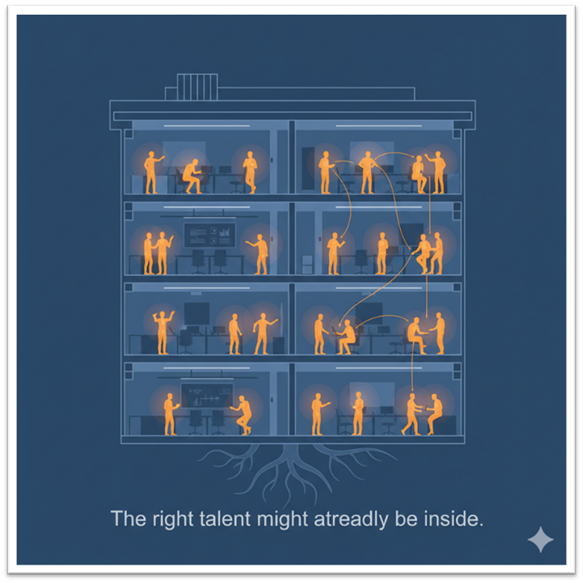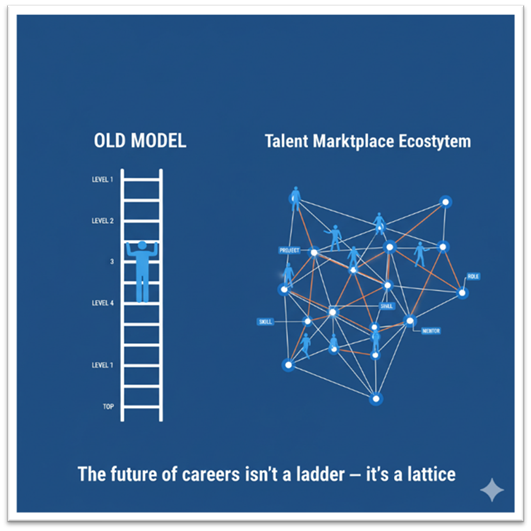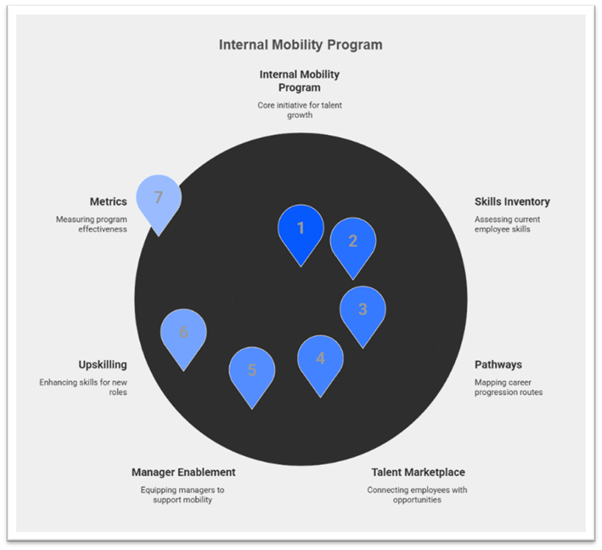When AI Becomes the Weapon: Why 2026 Will Be the Year Security Teams Fight Algorithms — Not Hackers
Executive Summary: 2026 – The Inflection Point of Algorithmic Warfare What happens when the hacker you are defending against no…
When enterprises talk about “finding the right talent,” the instinct is to look outward — hire new, hire fast, and hire more.
But here’s the twist: most of what they’re searching for is already in the building.
Across industries, organizations are beginning to rediscover a truth they’ve ignored for too long — their hidden workforce inside. Employees with untapped skills, adjacent expertise, or cross-functional potential are sitting right under their noses.
By combining data-driven workforce intelligence with flexible talent models — from on-demand specialists and contingent staff to full-time hires and project-based experts — companies are learning to redeploy talent strategically instead of replacing it.
With the rise of AI-powered internal mobility programs and intelligent talent marketplaces, leaders can now anticipate skill gaps, redeploy people faster, and build hybrid teams that blend stability with agility. The result? Lower turnover, higher engagement, and faster growth — without the hiring frenzy.
For organizations, this shift isn’t just operational. It’s transformative — a chance to build resilience and scalability from within, powered by smarter workforce design and talent innovation.

Talent shortages are crushing global markets, and enterprises feel it most. Recruiting externally takes longer and can often throw up cultural alignment challenges.
Here’s the data that tells the story:
In other words, hiring externally might fill seats, but internal mobility fills futures.
Internal talent moves faster, adapts more easily, and already believes in the brand. That’s why internal mobility strategy is fast becoming the number one retention play for Large-Scale organizations.
With a transparent talent marketplace, companies can redeploy employees into new roles, gigs, or stretch projects—keeping ambition alive and turnover low.
Think of a talent marketplace as your company’s internal LinkedIn, where opportunities find employees, and employees find opportunities.
It’s not a job board. It’s a living ecosystem powered by AI, where people are matched to projects, short-term gigs, mentorships, and roles based on fundamental skills, not just job titles.
Here’s what makes it game-changing:

According to a recent Harvard Business Review feature, companies using talent marketplaces are seeing measurable gains in engagement and productivity.
It’s not just a tool—it’s a shift in mindset. You’re moving from career ladders to career lattices, where growth is multidirectional, and employees are empowered to steer their own paths.
For big enterprises, this shift matters most because agility, not headcount, defines success.
Ready to uncover your hidden workforce? Here’s a framework to develop your internal mobility program from the ground up—designed for fast-growing organizations.
Step 1: Map your skills inventory
Start by identifying what you already have. Audit workforce skills, certifications, and potential. You can’t redeploy what you can’t see.
Step 2: Create pathways for internal hiring programs
Define what internal mobility means for your org: lateral moves, short-term projects, leadership rotations, or gig-style assignments.
Make sure policies encourage—not penalize- movement between teams.
Step 3: Launch your internal talent marketplace
Pilot a digital platform where managers can post projects or open roles, and employees can apply based on skills or interest.
Keep it transparent and accessible.
According to Deloitte, organizations implementing internal mobility frameworks saw 24% higher productivity and 33% better engagement.
Step 4: Train managers & employees
Teach managers to release talent rather than hoard it.
Coach employees to view lateral movement as growth, not risk.
Step 5: Link it to upskilling & reskilling
Internal mobility and learning must go hand in hand. Use insights from your talent marketplace to identify gaps and build personalized learning paths.
Step 6: Measure and iterate
Track metrics: internal hire ratio, mobility rate, time-to-fill, retention, engagement.
Continuous improvement is what separates successful internal hiring programs from token initiatives.

Building an internal mobility culture isn’t a plug-and-play exercise; it’s a behavioral shift. Here are the usual hurdles and how to beat them:
🚫 Manager resistance
Leaders fear losing top performers.
✅ Fix: Reward managers who contribute to cross-functional mobility. Recognize talent sharing as a leadership strength.
🚫 Lack of visibility
Employees don’t know what’s open or available.
✅ Fix: Centralize opportunities on your internal job marketplace. Make discovery easy and equitable.
🚫 Skills data chaos
You can’t match people to opportunities if you don’t know what they’re good at.
✅ Fix: Standardize your skills taxonomy and use AI to map evolving competencies. This creates cleaner internal talent pools, which strengthens both mobility and direct sourcing workflows.
🚫 Culture lag
Internal moves are often seen as risky or disloyal.
✅ Fix: Create success stories around internal redeployment. Celebrate internal transfers as career wins.
Companies that solve these cultural barriers early build employee engagement and retention into their DNA. And enterprises, being more agile, can set these habits before bureaucracy kicks in.
When it comes to mobility, the companies that win aren’t the biggest—they’re the ones with momentum.
They’re nimble enough to pivot and small enough to build a strong, people-first culture without endless red tape. That agility is precisely what makes them the perfect breeding ground for powerful internal mobility programs.
Here’s why the edge is yours
As your company scales, every promotion, lateral move, and project rotation becomes a story of career pathing in action. That’s what today’s workforce craves: movement, growth, and meaning.
By embedding internal mobility early, you future-proof your culture before bureaucracy takes over.
The next era of workforce management isn’t about control, it’s about connection.
Traditional career ladders are fading. What’s rising in their place are talent marketplaces that empower people to navigate their careers like ecosystems, not assembly lines.
In these dynamic networks, opportunities flow horizontally, diagonally, and vertically.
Employees don’t just apply for jobs—they’re matched to them based on skills, potential, and curiosity.
And when combined with upskilling and reskilling programs, this model builds a workforce that evolves with the business rather than lags behind it.
Companies that embrace this shift are seeing it pay off:
This is where internal mobility meets innovation, and where companies can outmaneuver slower competitors by letting AI, data, and curiosity fuel opportunity.
Here’s the truth: The war for talent isn’t about finding new people anymore.
It’s about finding new potential in your existing people.
Companies that master internal mobility programs and talent marketplaces don’t just retain talent, they release it into new spaces where it can grow, stretch, and evolve alongside business goals. And when you pair that with a smart direct sourcing strategy, you create a hiring engine that fills critical gaps without relying solely on external recruitment.
And for big organizations, that’s the ultimate advantage: agility without chaos, scalability without burnout, and engagement that doesn’t need constant hiring to sustain it.
Your hidden workforce is your most significant competitive edge. It’s time to rediscover it.
Ready to unlock your internal talent potential?
Partner with Compunnel Talent to design and deploy internal mobility strategies and talent marketplace solutions that transform your workforce from within.
